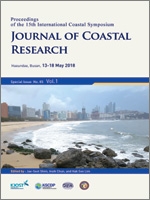Oh, Y.; Sohn, H.; Lee, D.; An, Y.-R.; Kang, C.-K.; Kang, M.G., and Lee, S.H., 2018. Feeding patterns of ‘Finless porpoise (Neophocaena asiaeorientalis)’ in the yellow sea as indicated by stable carbon and nitrogen ratios. In: Shim, J.-S.; Chun, I., and Lim, H.S. (eds.), Proceedings from the International Coastal Symposium (ICS) 2018 (Busan, Republic of Korea). Journal of Coastal Research, Special Issue No. 85, pp. 386–390. Coconut Creek (Florida), ISSN 0749-0208.
Finless porpoise (Neophocaena asiaeorientalis) is a representative marine mammal that has the largest habitat near the Korean coastal area. However, little information on their trophic ecology has been reported in Korea to date. The stable carbon and nitrogen isotope ratios from muscle samples (n = 60) were analyzed for their trophic ecology. The muscle tissues from the stranded or by caught porpoises in the Yellow Sea were obtained in 2015 (n = 37) and 2016 (n = 23) by Cetacean Research Institute in Korea. The averages of δ13C and δ15N for all the samples were −17.74 ‰ (S.D. = ±0.74 ‰) and 12.96 ‰ (S.D. = ±0.95 ‰), respectively. The mean isotopic values of the porpoise groups obtained from different seasons were −18.13 ‰ (±0.56 ‰) and 12.43 ‰ (±0.73 ‰) and −17.06 ‰ (±0.46 ‰) and 13.87 ‰ (±0.46 ‰) for summer (n = 38) and spring (n = 22), respectively, which were significantly different among the two seasons (t-test; p < 0.01, n = 60, respectively). These increasing isotope values from summer to spring reflected a shift in major prey sources. The small increasing in δ15N values could be caused partly by different body lengths of the porpoises. However, the most plausible reason for the large shift in δ13C value relative to δ15N could be a change from pelagic to benthic prey in the different seasons since benthic diets are reported for enriched δ13C over the pelagic diets. For better understanding, further validation should be conducted.





